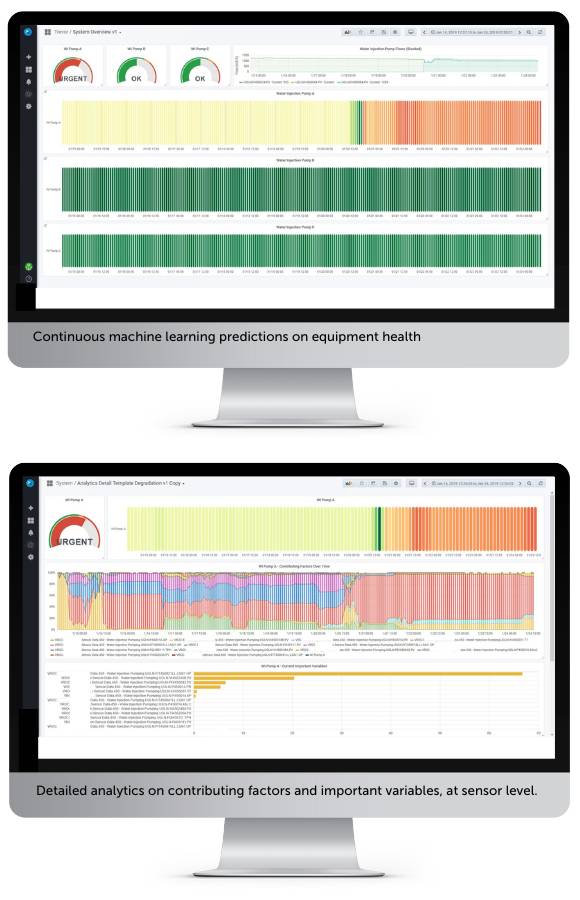I love the software, it gives me confidence that my equipment is working correctly, and that we're on top of our maintenance.'
Maintenance Superintendent
Process industries are plagued by unplanned downtime, at a cost upwards of $100,000 per hour for large manufacturers. It's no wonder that predictive maintenance is called the 'holy grail' of maintenance engineering, and why an increasing number of businesses are adopting it.
Unlike rule-based predictive maintenance, VROC's machine learning-based predictive maintenance platform OPUS, uses sensor data and machine learning to detect anomalies and predict failures ahead of time - without the high false positives common with threshold-based predictive maintenance. As most anomalies occur from unexpected failure patterns, OPUS has been uniquely designed to continuously learn from historical and live data to predict future performance.
With OPUS, operators benefit from the following advanced insights,
With OPUS Engineers and Operators can use predictive maintenance to more accurately plan maintenance activities, increase equipment lifespan, asset uptime, and reduce maintenance costs and efforts.

OPUS can detect failures on new equipment, as well as ageing equipment. Without relying on AI model libraries, the single solution can be used throughout an organisation to model all assets, regardless of machinery type, so that predictive maintenance can be adopted at an enterprise level.
Condition-based maintenance is enhanced with AI which discovers machinery and equipment issues earlier. These AI insights can be rapidly produced by asset reliability engineers and maintenance engineers without any programming or coding knowledge. The existing team then reviews the insights and makes informed business decisions based on their operational knowledge.
In this approach the platform doesn’t replace these highly skilled individuals but enhances their decision-making ability, resulting in increased operational effectiveness.
Learn More About OPUS
OPUS allows for thorough root cause analysis, ensuring that you treat the cause of the problem rather than the outlining incidents. The AI models can identify unexpected causations of errors that human analysis is unable to locate, taking into consideration short and medium term contributing factors over time. This predictive analysis has the power to save millions of dollars spent maintaining equipment that continually fails.
See how VROC's accurate root cause analysis helped avoid a major safety incident
Leave the guess work behind. With OPUS you will know what, when and why equipment will fail, in advance. Through live data from sensors and historical learnings, our AI platform will monitor the health of your systems, tracking any off-spec deviations and alerting your team days or weeks before any incident occurs. This time to failure monitoring is critical for any high value asset, ensuring you remain in production and avoid costly sudden failures.
See how VROC detected the first ever failure on a water pump
OPUS can be used to form a baseline for new assets and to optimize settings from the very beginning. This can be used by the asset owner to build accountability, support warranty and performance claims, and to postpone first planned shutdowns.
See how VROC detected the first ever failure on a water pump
OPUS can assist with critical insights for improved shutdown planning, turnaround planning and alarm rationalization. With predictive insights Operators can improve their maintenance planning and avoid unplanned shutdowns altogether.
Read MoreAsset operators can monitor the condition of their equipment in real-time, anywhere in the world using OPUS. Improve asset performance management with accurate insights into your plant operations.
Ready to embark on a pilot project or roll-out the innovation enterprise wide? Perhaps you need assistance integrating your systems or accessing your data? We have a solution to help you as you progress through your digital transformation.
Interested in a demo of one of our data solution products?
DataHUB4.0 is our enterprise data historian solution, OPUS is our Auto AI platform and OASIS is our remote control solution for Smart Cities and Facilities.
Book your demo with our team today!
Ready to embark on a pilot project or roll-out AI innovation enterprise wide? Perhaps you need assistance integrating your systems or storing your big data? Whatever the situation, we are ready to help you on your digital transformation.
The efficient deployment, continuous retraining of models with live data and monitoring of model accuracy falls under the categorisation called MLOps. As businesses have hundreds and even.
Learn more about DataHUB+, VROC's enterprise data historian and visualization platform. Complete the form to download the product sheet.
Discover how you can connect disparate systems and smart innovations in one platform, and remotely control your smart facility. Complete the form to download the product sheet.
'OPUS, an artistic work, especially on a large scale'
Please complete the form to download the OPUS Product Sheet, and discover how you can scale Auto AI today.
Interested in reading the technical case studies? Complete the form and our team will be in touch with you.
Subscribe to our newsletter for quarterly VROC updates and industry news.